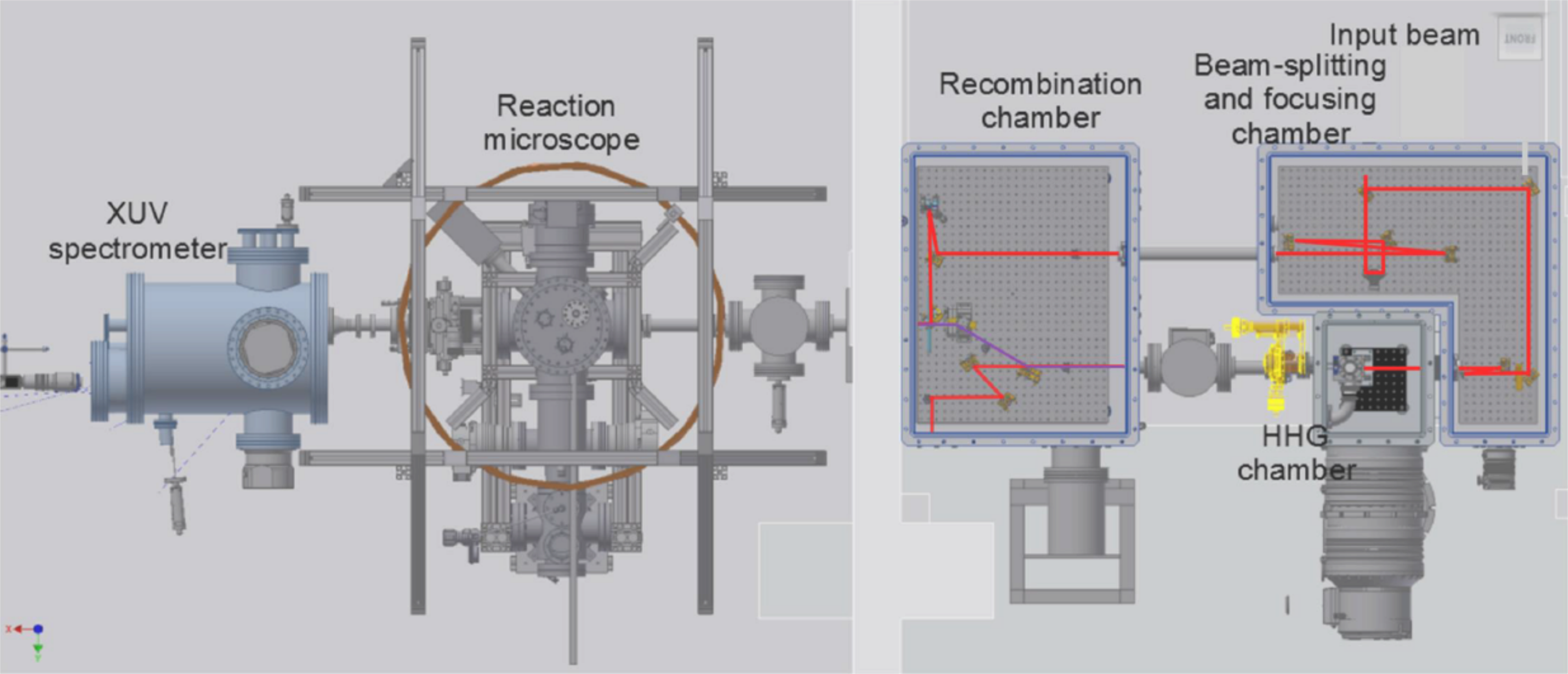Laserlab-Europe
MBI - Attosecond pump-probe with coincidence detection
Combination of carrier-envelope phase-stable few-cycle VIS-IR pulses and attosecond XUV pulses (trains or single pulses) in pump-probe configuration with sub-50 as resolution. Detection of photoelectrons and photoions in coincidence upon photo-ionization, utilizing a reaction microscope.
Status: Final phase of beamline preparation
Laser-based light source parameters
100 kHz attosecond pulse trains
Source type
High Harmonic Generation: Attosecond pulse trains. The peak photon energy can be changed by changing the generating gas and adjusting the driving laser intensity. Pulse energy and peak intensity are estimations
Peak Photon energy / central wavelenght
35 [eV]
Spectral Bandwidth FWHM / %
10000 - 40000 [meV]
Tunability
50 [%]
Beam shape
Gaussian
Pulse duration FWHM
400 [as]
Polarisation
Linear Vertical
Pulse repetition rate
100 * 103 [Hz]
Maximum pulse energy
10 * 10-12 [J]
Peak power
25000 * 109 [W]
100 kHz Isolated Attosecond Pulses
Source type
HHG driven by CEP stable source: Isolated attosecond pulses in the XUV. Peak photon energy can be changed by changing the gas medium and adjusting the intensity of driving laser. Pulse energy and peak intensity are estimations
Peak Photon energy / central wavelenght
35 [eV]
Spectral Bandwidth FWHM / %
10000 - 40000 [meV]
Tunability
50 [%]
Beam shape
Gaussian
Pulse duration FWHM
300 [as]
Polarisation
Linear Vertical
Pulse repetition rate
100 * 103 [Hz]
Maximum pulse energy
5 * 10-12 [J]
Peak power
17000 * 109 [W]
Additional Lightsources
100 kHz NIR OPCPA
Laser type
OPCPA. The main source is a noncollinear optical parametric chirped pulse amplifier. It delivers 0.19 mJ of energy per pulse at a repetition rate of 100 kHz (19 W of average power). The polarization of this source, without any modification is linear. The spectrum covers the range 670-1050 nm. The pulse duration is 7 fs. Pulses are Carrier-Envelope Phase-Stable
Central Wavelength/Energy
800 [nm]
Wavelength fluctuations
1 * 10-1 [%]
Spectral Bandwidth FWHM
670 - 1050 [nm]
Tunability
10 [%]
Beam shape
Gaussian
Pulse duration FWHM
7 [fs]
Polarisation
Linear Horizontal
Other polarisation
The polarization can be adjusted rather arbitrarily, although pulse compression needs to be readjusted in that case
Pulse repetition rate
100 * 103 [Hz]
Maximum pulse energy
190 * 10-3 [mJ]
Peak power
27 * 109 [W]
Post-compressed 100 kHz OPCPA
Laser type
OPCPA+nonlinear pulse compression stage. Polarization can be controlled arbitrarily. Pulse duration can be pushed to a lower limit of 3.2 fs (limited by dispersion compensation mirrors) and in general is <4fs. Nonlinear spectral broadening is done either by propagation of intense OPCPA pulses in a gas-filled hollow-core fiber, or through thin quartz plates. Pulses are Carrier-Envelope Phase-Stable
Central Wavelength/Energy
800 [nm]
Wavelength fluctuations
1 * 10-1 [%]
Spectral Bandwidth FWHM
500 - 1100 [nm]
Tunability
10 [%]
Beam shape
Gaussian
Pulse duration FWHM
35 * 10-1 [fs]
Polarisation
Linear Vertical
Pulse repetition rate
100 * 103 [Hz]
Maximum pulse energy
100 * 10-3 [mJ]
Peak power
29 * 109 [W]
Techniques
Ion Spectroscopy
- Ion imaging
- Mass spectrometry
Photoelectron emission
- Angular Resolved PES
- Time-resolved studies
Disciplines
Physics
- Atomic & molecular physics
control/Data analysis
Control Software Type
- COBOLD/Python
Data Output Type
- Binary files
Data Output Format
- COBOLD Internal file format
Softwares For Data Analysis
- Root (https://root.cern.ch/)
Layout
